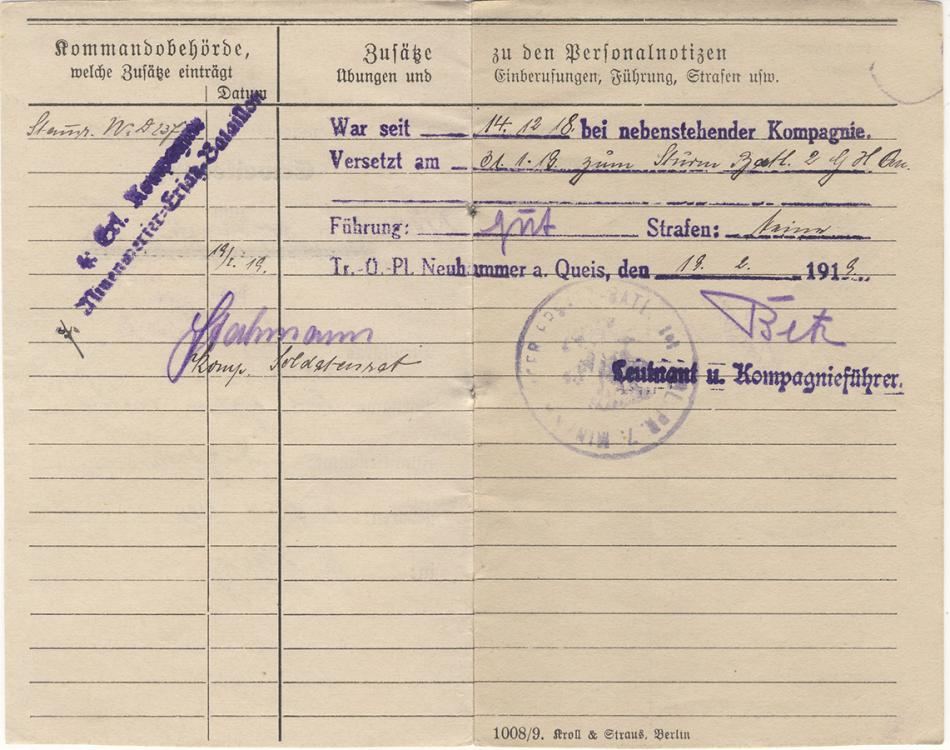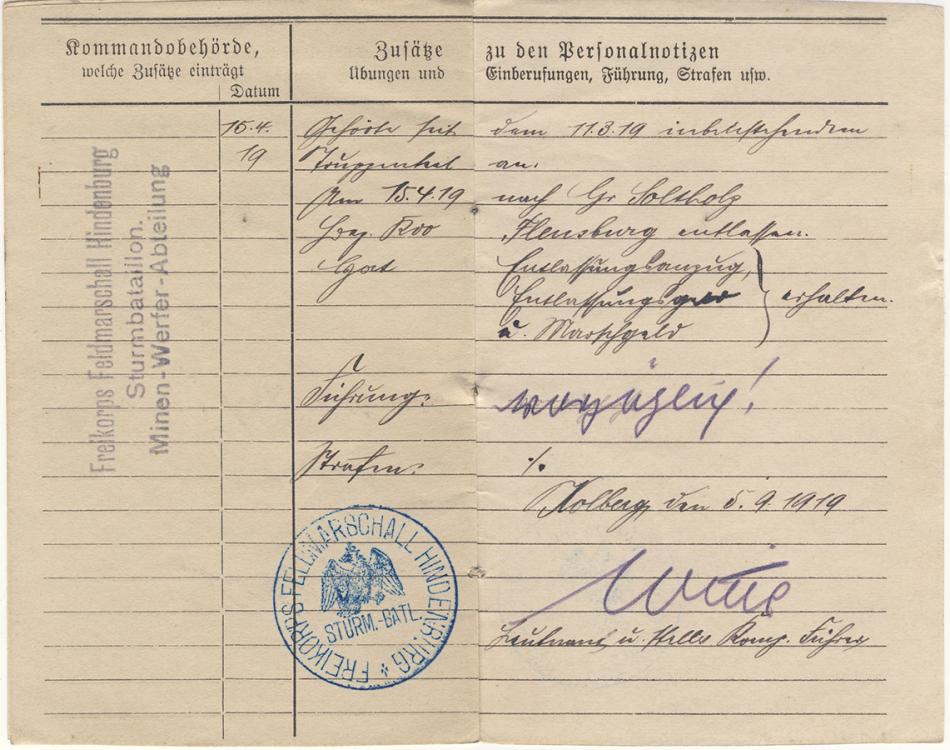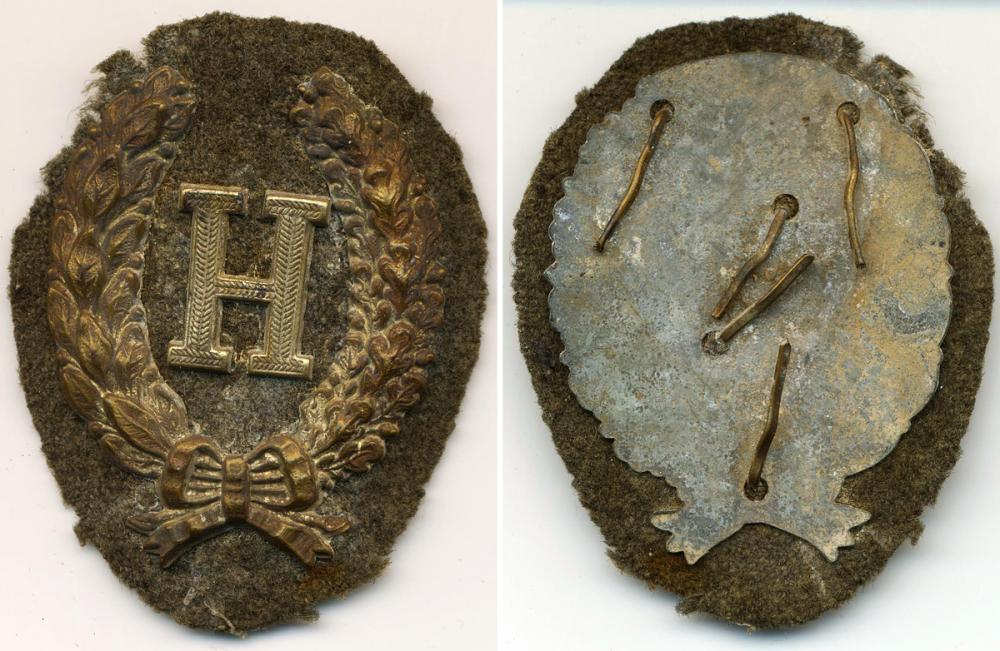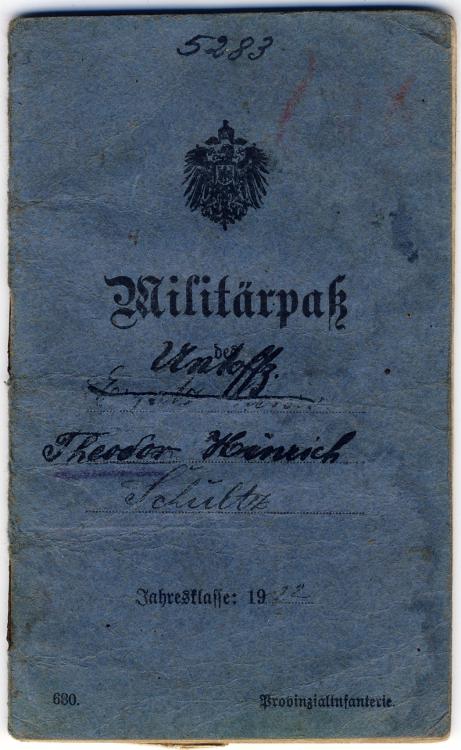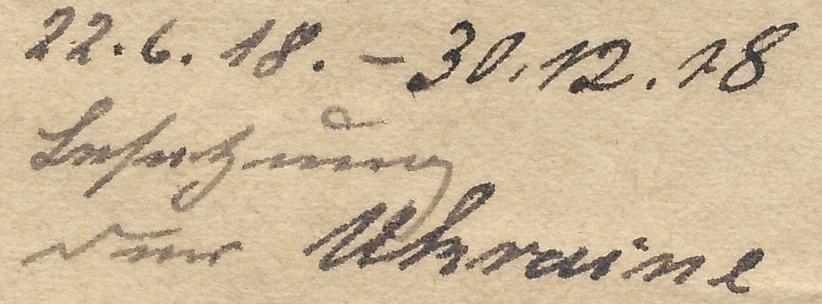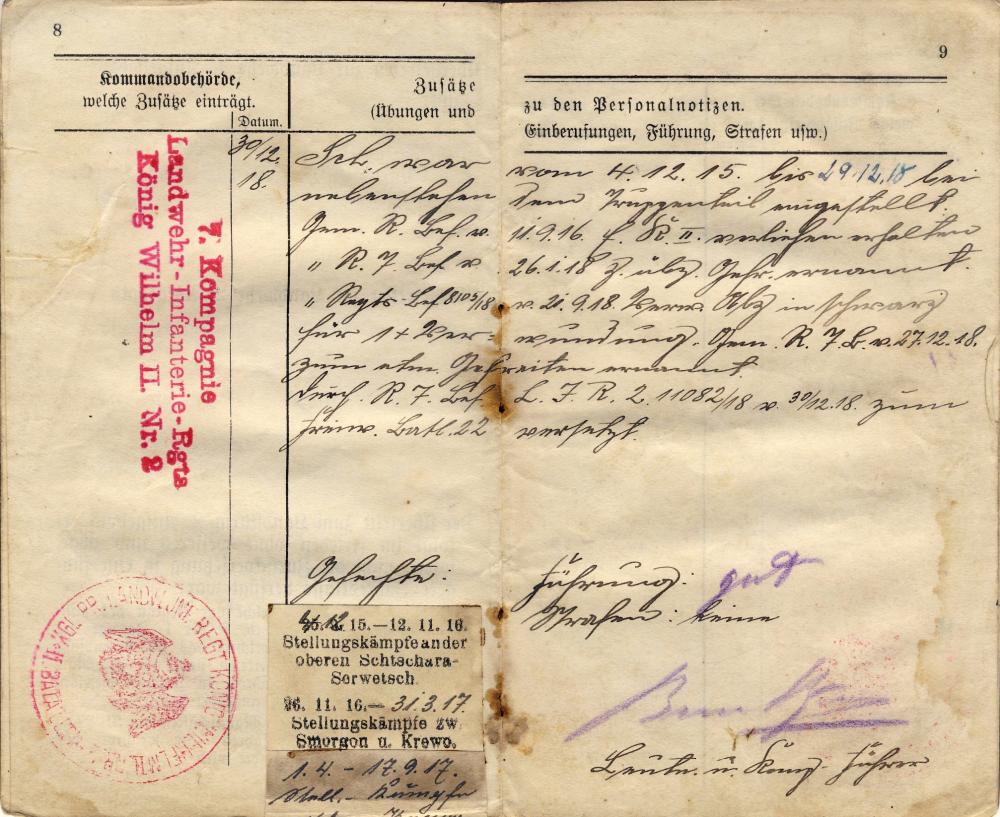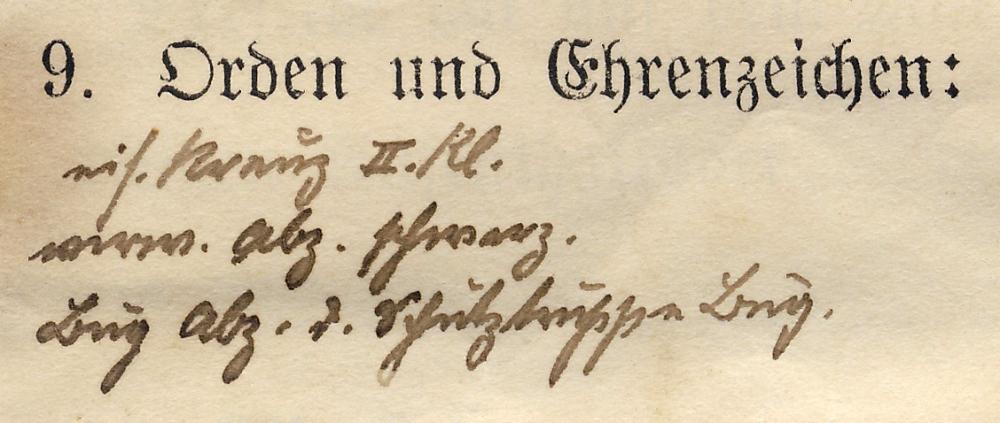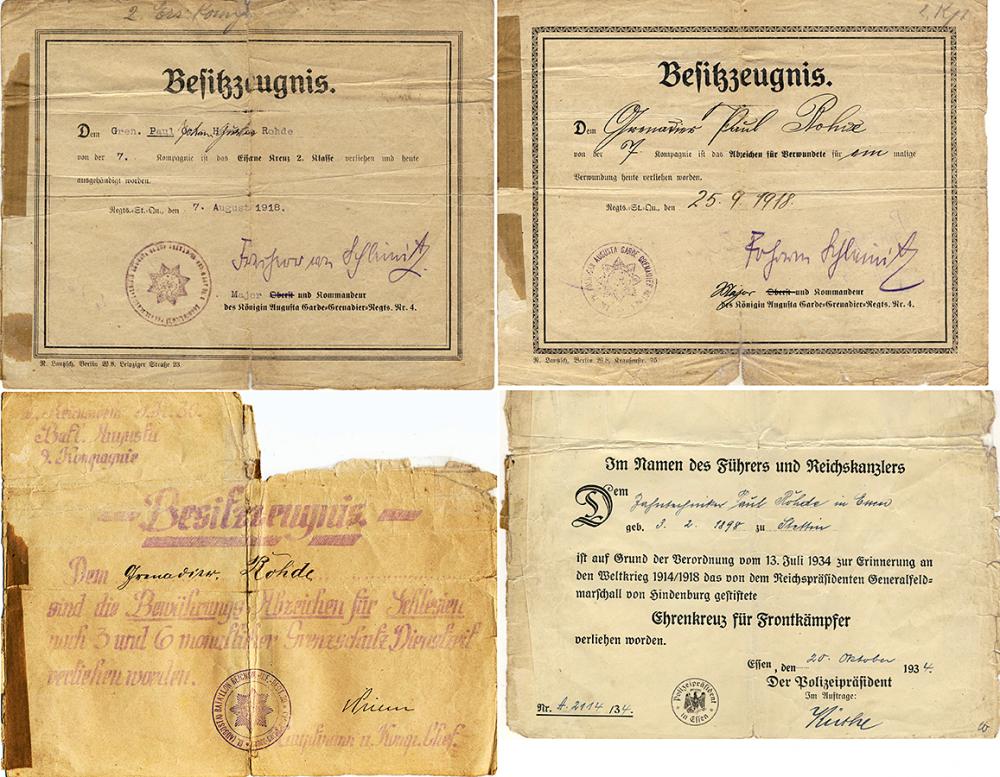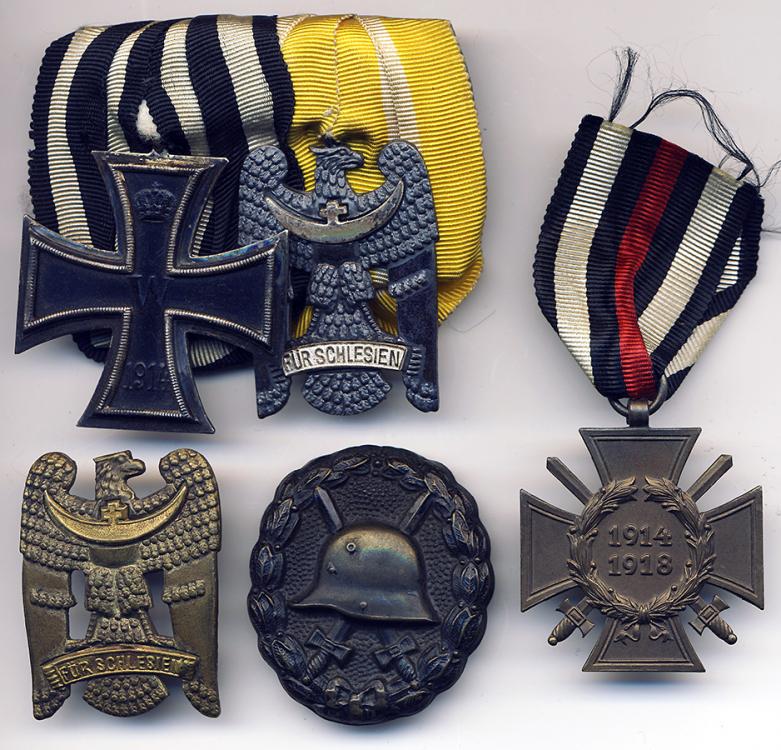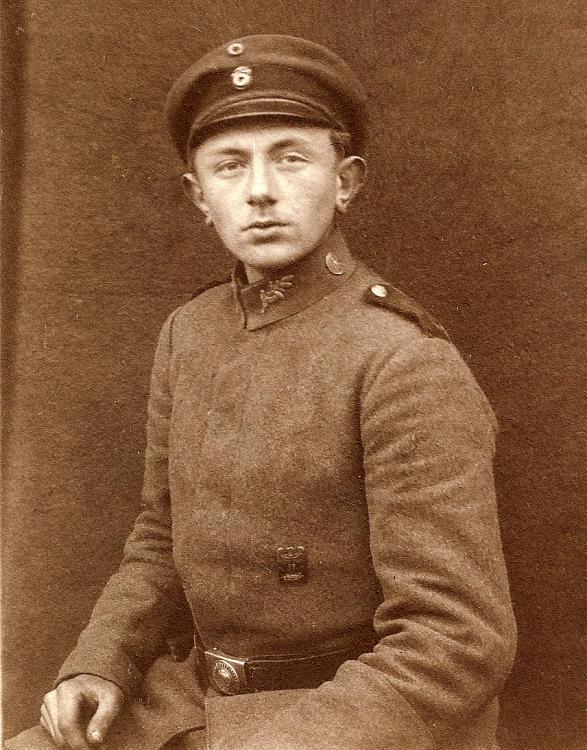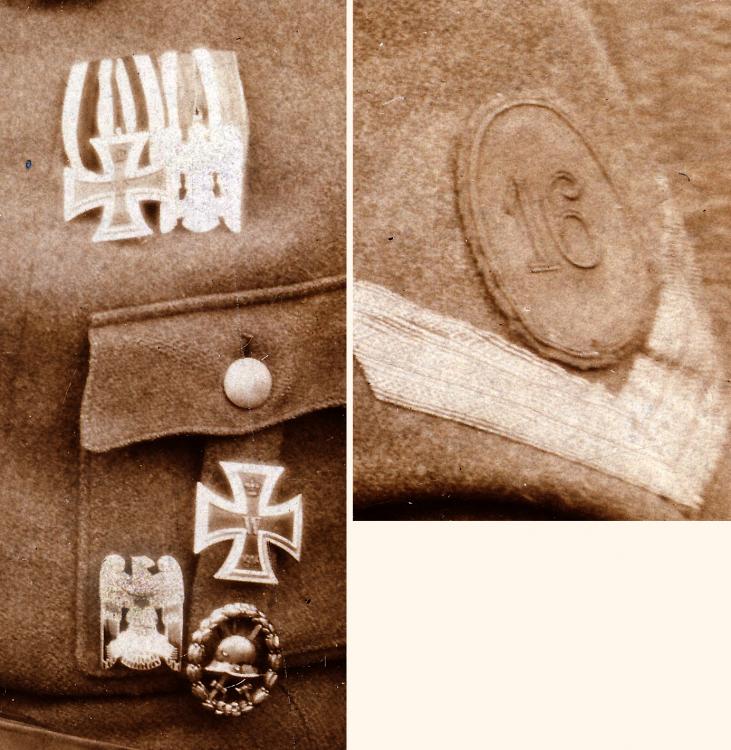
bolewts58
Active Contributor-
Posts
598 -
Joined
-
Last visited
-
Days Won
9
Content Type
Profiles
Forums
Blogs
Gallery
Events
Store
Everything posted by bolewts58
-
Freikorps Insignia
bolewts58 replied to Nick's topic in Germany: Weimar Republic & Deutsche Freikorps
That makes more sense. Unfortunately, given the less than perfect database available on Freikorps material, it allows for dealers to make all kinds of spurious claims. So, in the case of this badge, it is often referred to as the Hubertus badge of Freikorps Rossbach, when no such badge ever existed. FK Rossbach used the staghead without crown only, as did several other Freikorps. None used it with a crown. -
mega Freikorps group Photo
bolewts58 replied to dedehansen's topic in Germany: Weimar Republic & Deutsche Freikorps
The bottom photo is: Freiwilligentruppen der 32.Reichswehr Brigade / Freiwillige 12. (Schlesische) Infanterie-Division. -
Freikorps Insignia
bolewts58 replied to Nick's topic in Germany: Weimar Republic & Deutsche Freikorps
I believe the Bug Stern is a fake. Can you show the reverse? I also believe the skull in photo #6 is a fake. The Hubertus Stag-head badge is not Freikorps, but Imperial Jäger Kaiser prize. Also, those are not Freiwilligen Landesjägerkorps collar badges which were silver not gold.They are Freikorps Hülsen. -
Freikorps photo Hamburg October 1919
bolewts58 replied to dedehansen's topic in Germany: Weimar Republic & Deutsche Freikorps
Minenwurfer Sturm-Detachment Heusckel -
An interesting Militärpass supplement to a Pionier Karl Butzbach of Kongl. Preuss. Sturm Batl. 2. and later the Sturm Batl. of the Minenwerfer-Abtl. of Freikorps Feldmarschall Hindenburg. Interestingly, his conduct in the Freikorps was marked as 'excellent' (vorzüglich). Also attached is the sleeve-badge worn by Freikorps Feldmarschall Hindenburg.
-
I acquired this Militärpass awhile ago principally because of the Freikorps connection which is my main area of interest. However, what's more interesting is that the recipient, Unteroffizier Theodor Heinrich Schultz was in Landwehr IR 2. and fought in the Battle of Smorgon and Krewo and all the other actions of 226th Inf. Division from 1916-1918. He served in occupation forces in Ukraine from June-Dec. 1918 and then was in Batl. 22 (Schutztruppe Bug) from Dec. 30, 1918 until he mustered out on February 26, 1919 just before Schutztruppe Bug was absorbed into Brigade Olita. He was awarded the EKII, Black Wound Badge and the Bug Abzeichen der Schutztruppe Bug (Bug Stern).
-
Schlesischer Adler / Silesian Eagles
bolewts58 replied to dond's topic in Germany: Weimar Republic & Deutsche Freikorps
Thank you for the correction - Johann Gustav. I had a thought that maybe he had a son whose name was Paul Johann Gustav Rohde, who found the the document and wrote his name over his father's as a prank. Not a very German thing to do. But, I'm at a loss as to why it's been over-written like this. -
Schlesischer Adler / Silesian Eagles
bolewts58 replied to dond's topic in Germany: Weimar Republic & Deutsche Freikorps
Can you explain that more? I don't quite understand. There's another name handwritten over Rohde's on the EK doc (Johann Gusten??). I've never understood why that's there, as this is definitely Rohde's EK doc. -
Schlesischer Adler / Silesian Eagles
bolewts58 replied to dond's topic in Germany: Weimar Republic & Deutsche Freikorps
Here's a rather "salty" set of documents (especially the mimeographed Schlesien Adler doc) complete with medals to: Grenadier/Sanitäter Paul Rohde, III (Augusta) Batln. Reichswehr Inf. Regt. 30 (Garde Grenadier Regiment). By 1934, Rohde was a Dental Technician, as indicated on his Hindeburg Cross document. On an official leave document from March 1920 (not shown), Rohde's rank is that of a Sanitäter, or army medic. So, perhaps he was a dental assistant in the later stages of his military service, which he continued in civilian life. Docs and Medals: EKII, Black Wound Badge, Silesian Eagle I and II, Hindenburg Cross. The medals show very little wear with the exception of the Silesian Eagle I. Therefore, I think it's likely that Rohde only wore his SAI in the field, which would account for most of the silver finish being gone on the obverse. The silver finish is largely intact on the reverse. The EKII and Wound Badge documents are signed by Pour le Merite winner Major Freiherr von Schleinitz, commander of Königin Augusta Garde-Grenadier-Regiment Nr. 4., and the Freikorps successor units Vol. Btln. Guards Grenadier Regt. 4 (Augusta) and Reichswehr Inf. Regt. 30 (Garde Grenadier Regiment) from Juy 26, 1918 - March 12, 1919. Schleinitz later became Commander of Freikorps Hindenburg and was a General der Infanterie in WWII. The III (Augusta) Batln. Reichswehr Inf. Regt. 30 (Garde Grenadier Regiment) was initially designated as Vol. Btln. Guards Grenadier Regt. 4 (Augusta), as part of Vol. 2nd Guards Infantry Division/ 3rd Vol. Guards Infantry Brigade formed in November 1918 from Königin Augusta Garde-Grenadier-Regiment Nr. 4, the regiment in which Rohde served during the war (noted on his EKII and Wound Badge documents). The 2nd Guards Infantry Division was never demobilized in 1918, and with its war formation intact was sent into Upper Silesia as early as November 1918 only a short time after the Armistice. On 13 March 1919 the Division formed 2nd Division Freikorps Schlesien. This formation went to Munich on April 28 and took part in the Freikorps assault on the city on May 3, which defeated the Munich Soviet Red Army. The unit then returned to border defence in Upper Silesia throughout 1919 and 1920. It formed together with Freikorps Eulenburg, Reichswehr Brigade 26 in Fürstenwalde in June 1919. It merged with Reichswehr Brigade 34 to become Reichswehr Brigade 15 in October 1919 in the Übergangsheer -
Freikorps Insignia
bolewts58 replied to Nick's topic in Germany: Weimar Republic & Deutsche Freikorps
I have never seen either the lapel pin or arm-badge in a photo. The lapel pins are fairly common and the ones I've seen over the last 30 years or so, all have the same construction. So, I assume they're real. I haven't heard of this particular badge being faked. The arm-badges, on the other hand are extremely rare. -
The first pass belongs here as it has the Weimar/Freikorps service for the Suppression of Unrest in the industrial area of Rhineland-Westfalia which was a trade union/communist uprising in the Ruhr region in 1920. The Reichswehr/Freikorps attempted suppression in the Ruhr coincided with the Lüttwitz-Kapp Putsch in Berlin, the attempted suppression of the Thuringia workers uprising and the von Hahr Putsch in Munich. All the Reichswehr/Freikorps actions were complete failures. While obviously not indicated in the pass, your Jäger and his unit were forced to retreat by the onslaught of the workers.
-
Silesian Eagles in wear
bolewts58 replied to TerryG's topic in Germany: Weimar Republic & Deutsche Freikorps
Feldwebel of the Freiwilligentruppen der 32. Reichswehr-Brigade / Freiwillige 12. (Schlesische) Infanterie-Division. He wears the insignia of this unit consisting of a silvered pine bow collar badge and a Danzig skull between the cap cockades. -
Silesian Eagles in wear
bolewts58 replied to TerryG's topic in Germany: Weimar Republic & Deutsche Freikorps
-
1873 Freikorps Kreuz
bolewts58 replied to Tom63's topic in Germany: Weimar Republic & Deutsche Freikorps
The place name is "St. C." not "W". The "St" stands for "Sankt" (Saint). -
Got a soapbox filled with medals
bolewts58 replied to dedehansen's topic in Germany: Weimar Republic & Deutsche Freikorps
I'm not talking about that clasp. I'm talking about the other 3. They are for the Flandernkreuz. -
Some did and some had facsimile signatures. Not for any award because for one thing, there were no Freikorps awards authorized under the Third Reich other than the Silesian Eagle, Baltic Cross and Carinthian Cross. These certificates were given as a form of recognition and appreciation to former Freikorps vets from any of the Freikorps units. So, you can for instance see them made out to the Ehrnardt Brigade, Freikorps Epp, Iron Division etc. They are either typed or written by hand. You see them both ways.
-
The skull and hand-grenade with 'St' (Sturmtruppen?) likely indicates a hitherto unknown (at least by me) Sturmtruppen badge and I would bet it's Austrian. I'm sure it has nothing to do with the medal. But, as you say, it likely belonged to the same person and he just stuck it on the ribbon. It's cool, whatever it is.



